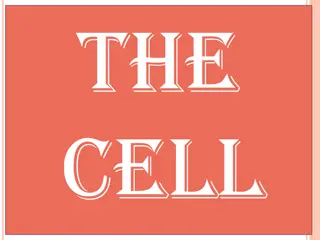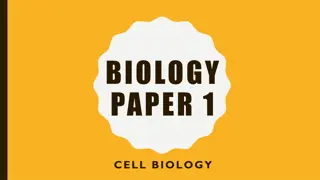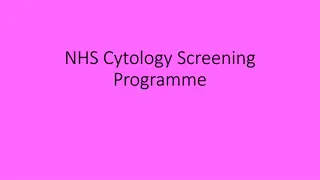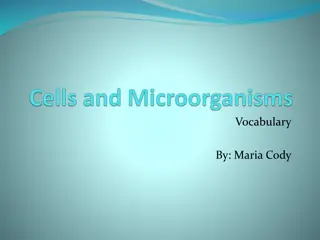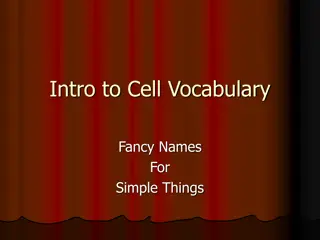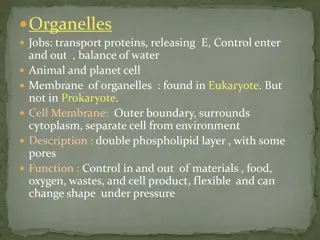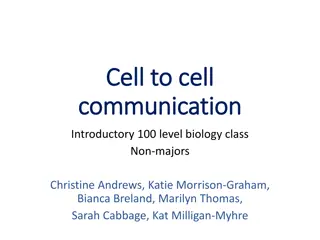An Overview of Cell Biology: From Cytology to Modern Studies
Cell biology, also known as cytology, explores cells from various perspectives including physiological, developmental, and evolutionary aspects. Modern Cell Biology delves into the mechanisms of metabolism, heredity, and evolution at the molecular level, involving proteins, RNAs, and DNA. The comparison between prokaryotic and eukaryotic cells highlights their structural and functional differences. The history of cell studies from early microscopes to the cell theory is also discussed.
Download Presentation

Please find below an Image/Link to download the presentation.
The content on the website is provided AS IS for your information and personal use only. It may not be sold, licensed, or shared on other websites without obtaining consent from the author. Download presentation by click this link. If you encounter any issues during the download, it is possible that the publisher has removed the file from their server.
E N D
Presentation Transcript
The cytology or cell biology (Gr., Kytos-hollow vessel or cell, logos- to discourse) is a biological science which deals with the study of cells from physiological, developmental, genetical, pathological and evolutionary point of views. morphological, biochemical, Modern Cell Biology is attempting to interpret and explain the phenomenon of metabolism, biosynthesis, heredity, sex, variation, mutation, and evolution of living organisms in terms of molecules or macromolecules such as proteins, ribonucleic acids (RNAs) and deoxyribonucleic acid (DNA)
Loewy and Siekevitz (1963) have defined that a unit of biological activity delimited by a selective permeable membrane and capable of self reproducing in a medium free of other living system .
Comparison of Prokaryotes and Eukaryotes Characteristics Prokaryotes Eukaryotes Nucleus Absent Present with nuclear membrane Organelles Absent Present in a variety of forms DNA structure Single closed loop Multiple chromosomes Chlorophyll When present, dissolved in cytoplasm When present, contained in chloroplast Ribosomes Smaller than eukaryotic ribosomes Free in cytoplasm Larger than prokaryotic ribosomes Bound to membrane Present in some types, absent in others Simple chemical composition Cell Wall Generallypresent Complex chemical composition Reproduction Usually by fission No evidence of mitosis Sexual reproduction unusual By mitosis Sexual reproduction usual Examples Bacteria, Rickettsiae, Chlamydiae Fungi, Protozoa, Plants, Animals, Humans etc
The simplest of unicellular organism to very complex higher plants and animals, is composed of cells and that each cell can not act independently but functions as integral part of the complete organisms. cell theory holds that all living matter, from the
Year 1595 1655 Scientist Contribution Zacharias Jensen Robert Hooke Creates the first compound microscope Hooke, using the microscope that he devised, viewed the cell walls of cork for the first time. He coined the term Cell 1670 Antonie Van Leeuwenhoek Observes the first living cells in pond water using lenses that he created for his microscope 1833 1838 Robert Brown Matthias Jakob Schleiden Discovers the nucleus in plant cells Proposed that all plant tissues are composed of cells Concludes that not just plant tissue, but animal tissues, as well , are composed of one or more cells. He also states that the cell is the basic unit for all organism. 1839 Theodor Schwann 1845 Carl Heinrich Braun Re states the second part of the cell theory proposing that cells are the basic unit of life 1855 Rudolf Virchow Add the last part of the cell theory stating that cells only come from other living cells.
Schawan believed that cell could be spontaneously generated by a process analogous to crystal formation. But studies of developing embryos showed that during growth, cells duplicated themselves by cell division. These observation were summarized by Rudolf Virchow in 1858 and he stated where a cell exists there must have been a pre-existing cell, just as the animal arises only from an animal and the plant only from a plant .
Various cytological investigations have shown that all living organisms are not cellular as considered by the cell theory and some organisms are without any true cell or acellular. A true cell has been defined as mass of protoplasm having a distinct nucleus and limited by plasma membrane; but most viruses have no protoplasm and nucleus but only DNA or RNA as the genetic material.
The bacteria and blue green algae have no true cell and in them the nuclear material does not remain bounded by the nuclear membranous and have direct contact with that of cytoplasm. Moreover, certain algae such as Vaucheria and certain fungi, such as Rhizopus are unexplainable according to the cell theory because their bodies are made up of the undivided mass of protoplasm in which many nuclei remain scattered. These are the examples from the exceptions to cell theory.
In the middle of the 19thcentury, various biologist started to recognize the importance of Juicy or Slimy contents of the cells. Purkinje (1839) gave the name protoplasm (Gr., Protos- primitive or first, plasma- substance) to the contents of the cells. This theory states that the cell is an accumulation of living substance or protoplasm, definitely limited in space and possessing a nucleus and a cell membrane .
1. Cytology by P. S. Verma and V. K. Agarwal 2. The World of the Cell by Wayne M. Beeker, Jeff Hardin and Lewis J. Kleinsmith 3. Molecular Biology of the Cell by Bruce Alberts, Dennis Bray, Julian Lewis, Martin Raff, Keith Roberts . 4. Molecular Cell Biology by Harvey Lodish, D. Baltimore 5. Cell Biology by De Robertes 6. Cell Biology by S. C. Rastogi

















